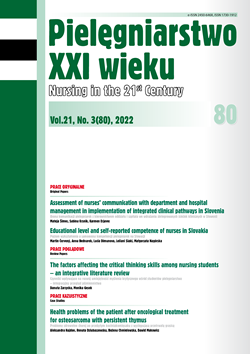Ocena komunikacji pielęgniarek z kierownictwem oddziału i szpitala we wdrażaniu zintegrowanych ścieżek klinicznych w Słowenii
DOI:
https://doi.org/10.2478/pielxxiw-2022-0022Słowa kluczowe:
pielęgniarka, komunikacja, zintegrowana ścieżka kliniczna, zarządzanie szpitalemAbstrakt
OCENA KOMUNIKACJI PIELĘGNIAREK Z KIEROWNICTWEM ODDZIAŁU I SZPITALA WE WDRAŻANIU ZINTEGROWANYCH ŚCIEŻEK KLINICZNYCH W SŁOWENII
Wprowadzenie. Ważnym czynnikiem we wdrażaniu innowacji, takich jak integracyjne ścieżki opieki klinicznej (ICP), jest wspierająca komunikacja ze strony kierownictwa oddziału i szpitala.
Cel pracy. Badanie miało na celu ocenę komunikacji pielęgniarek pracujących w trzech ICP oraz kierowników oddziałów i kierowników szpitali w typowym słoweńskim szpitalu oraz zidentyfikowanie głównych powodów tej komunikacji przy użyciu podejścia metod mieszanych.
Materiał i metody. W badaniu przekrojowym wykorzystano metodę ilościową z ankietą oraz metodę jakościową z wywiadami zogniskowanymi grupami pielęgniarek pracujących w ICP w zakresie: przewlekłe choroby nerek, udar i całkowita endoprotezo plastyka stawu biodrowego w słoweńskim szpitalu.
Wyniki i wnioski. Wyniki pokazały, że komunikacja odgrywa ważną rolę we wdrażaniu ICP i że pielęgniarki gorzej komunikuj się z kierownikami szpitali niż z kierownikami oddziałów, niezależnie od wieku, płci, wykształcenia i ICP. Głównymi przyczynami słabej komunikacji w realizacji ICP są zależne od komunikacji (słaba wymiana informacji, brak odpowiednich kanałów komunikacji, jednostronna i autorytatywna komunikacja ze strony kierowników szpitali) oraz organizacyjne (brak personelu, dezorganizacja pielęgniarstwa personel).
Bibliografia
1. Cook S, Scott M. Framework for the implementation of integrated care pathways: Part 2. Journal of Integrated Care Pathways. 2005; 9(1): 39-45.
2. Hogan C, Barry M, Burke M, et al. Healthcare professionals’ experiences of the implementation of integrated care pathways. International journal of health care quality assurance. 2011; 24(5): 334-347.
3. Busetto L, Luijkx K, Calciolari S, et al. Barriers and Facilitators to Workforce Changes in Integrated Care. International journal of integrated care. 2018; 18(2): 17.
4. Vanhaecht K, De Witte K, Sermeus W. The impact of clinical pathways on the organisation of care processes. PhD dissertation, Belgium: KU Leuven; 2007.
5. Sleeman KE, Koff man J, Bristowe K, et al. It doesn’t do the care for you: a qualitative study of health care professionals’ perceptions of the benefi ts and harms of integrated care pathways for end of life care. BMJ Open. 2015; 5(9): 1-7.
6. Seys D, Panella M, VanZelm R, et al. Care pathways are complex interventions in complex systems: New European Pathway Association framework. International Journal of Care Coordination. 2019; 22(1): 5-9.
7. Schrijvers G, van Hoorn A, Huiskes N. The care pathway: Concepts and theories: An introduction. International journal of integrated care. 2012; 12(I).
8. de Stampa M, Vedel I, Bergman H, et al. Fostering participation of general practitioners in integrated health services networks: incentives, barriers, and guidelines. BMC Health Services Research. 2009; 9: 48.
9. Mc Hugh S, O’Mullane M, Perry IJ, et al. Barriers to, and facilitators in, introducing integrated diabetes care in Ireland. BMJ Open. 2013; 3: e003217.
10. Carmont S-A, Mitchell G, Senior H, et al. Systematic review of the eff ectiveness, barriers and facilitators to general practitioner engagement with specialist secondary services in integrated palliative care. BMJ Support Palliative Care. 2018; 8: 385-399.
11. Averlant L, Calafi ore M, Puisieux F, et al. Barriers and Facilitators in the Uptake of Integrated Care Pathways for Older Patients by Healthcare Professionals: A Qualitative Analysis of the French National “Health Pathway of Seniors for Preserved Autonomy” Pilot Program. International journal of integrated care. 2021; 21(2): 7.
12. Deneckere S, Euwema M, Lodewijckx C, et al. The European quality of care pathways (EQCP) study on the impact of care pathways on interprofessional teamwork in an acute hospital setting: study protocol: for a cluster randomized controlled trial and evaluation of implementation processes. Implementation Science. 2012; 7: 47.
13. Wilson, Sonja B. Nurses’ Perspective of Leadership Communication and Nursing Churn in an Upstate South Carolina Hospital. Dissertations: Northcentral University, 2019.
14. Aquino MRJ, Mullis R, Moore C, et al. “It’s Diffi cult, There’s No Formula”: Qualitative Study of Stroke Related Communication between Primary and Secondary Healthcare Professionals. International journal of integrated care. 2020; 20(4): 1-10.
15. Feigin VL, Norrving B, Mensah GA. Global Burden of Stroke. Circulation Research. 2017; 120(3): 439-448.
16. Rubin S, Orieux A, Clouzeau B, et al. The Incidence of Chronic Kidney Disease Three Years after Non-Severe Acute Kidney Injury in Critically Ill Patients: A Single-Center Cohort Study. Journal of Clinical Medicine. 2019; 8(12): 2215.
17. Lankhorst NE, Damen J, Oei EH, et al. Incidence, prevalence, natural course and prognosis of patellofemoral osteoarthritis: the Cohort Hip and Cohort Knee study. Osteoarthritis and Cartilage. 2017; 25(5): 647-653.
18. Cramm JM, Nieboer AP. Professionals’ views on interprofessional stroke team functioning. International journal of integrated care. 2011; 11: e081.
19. Hustoft M, Hetlevik Ø, Aßmus J, et al. Communication and Relational Ties in Inter- Professional Teams in Norwegian Specialized Health Care: A Multicentre Study of Relational Coordination. International journal of integrated care. 2018; 18(2): 9.
20. Karatuna I, Jönsson S, Muhonen T. Workplace bullying in the nursing profession: A cross-cultural scoping review. International journal of nursing studies. 2020; 111: 103628-103628.
Pobrania
Opublikowane
Numer
Dział
Licencja
Prawa autorskie (c) 2022 Autorzy

Utwór dostępny jest na licencji Creative Commons Uznanie autorstwa 4.0 Międzynarodowe.




